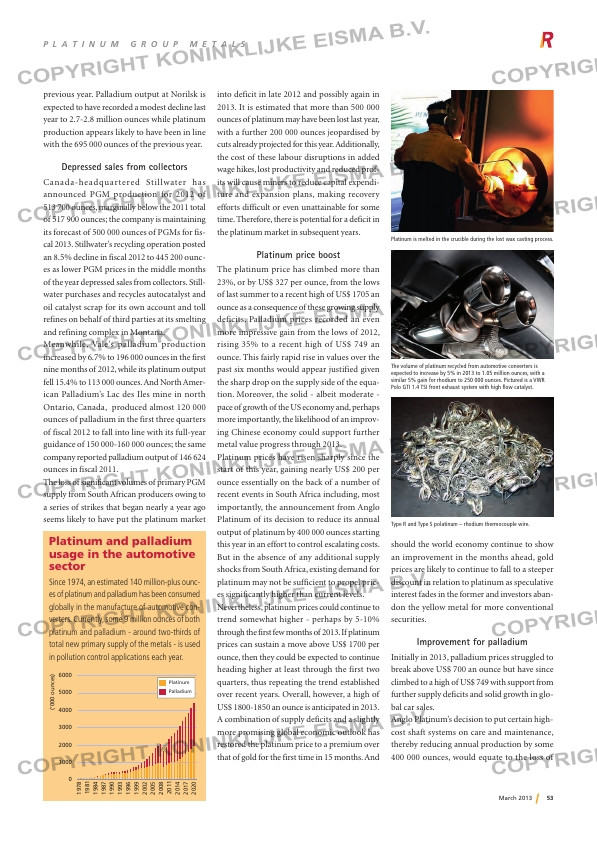Page 53 from: March 2013

53March 2013
previous year. Palladium output at Norilsk is
expected to have recorded a modest decline last
year to 2.7-2.8 million ounces while platinum
production appears likely to have been in line
with the 695 000 ounces of the previous year.
Depressed sales from collectors
Canada-headquartered Stil lwater has
announced PGM production for 2012 of
513 700 ounces, marginally below the 2011 total
of 517 900 ounces; the company is maintaining
its forecast of 500 000 ounces of PGMs for fis-
cal 2013. Stillwater’s recycling operation posted
an 8.5% decline in fiscal 2012 to 445 200 ounc-
es as lower PGM prices in the middle months
of the year depressed sales from collectors. Still-
water purchases and recycles autocatalyst and
oil catalyst scrap for its own account and toll
refines on behalf of third parties at its smelting
and refining complex in Montana.
Meanwhile, Vale’s palladium production
increased by 6.7% to 196 000 ounces in the first
nine months of 2012, while its platinum output
fell 15.4% to 113 000 ounces. And North Amer-
ican Palladium’s Lac des Iles mine in north
Ontario, Canada, produced almost 120 000
ounces of palladium in the first three quarters
of fiscal 2012 to fall into line with its full-year
guidance of 150 000-160 000 ounces; the same
company reported palladium output of 146 624
ounces in fiscal 2011.
The loss of significant volumes of primary PGM
supply from South African producers owing to
a series of strikes that began nearly a year ago
seems likely to have put the platinum market
into deficit in late 2012 and possibly again in
2013. It is estimated that more than 500 000
ounces of platinum may have been lost last year,
with a further 200 000 ounces jeopardised by
cuts already projected for this year. Additionally,
the cost of these labour disruptions in added
wage hikes, lost productivity and reduced prof-
its will cause miners to reduce capital expendi-
ture and expansion plans, making recovery
efforts difficult or even unattainable for some
time. Therefore, there is potential for a deficit in
the platinum market in subsequent years.
Platinum price boost
The platinum price has climbed more than
23%, or by US$ 327 per ounce, from the lows
of last summer to a recent high of US$ 1705 an
ounce as a consequence of these growing supply
deficits. Palladium prices recorded an even
more impressive gain from the lows of 2012,
rising 35% to a recent high of US$ 749 an
ounce. This fairly rapid rise in values over the
past six months would appear justified given
the sharp drop on the supply side of the equa-
tion. Moreover, the solid – albeit moderate –
pace of growth of the US economy and, perhaps
more importantly, the likelihood of an improv-
ing Chinese economy could support further
metal value progress through 2013.
Platinum prices have risen sharply since the
start of this year, gaining nearly US$ 200 per
ounce essentially on the back of a number of
recent events in South Africa including, most
importantly, the announcement from Anglo
Platinum of its decision to reduce its annual
output of platinum by 400 000 ounces starting
this year in an effort to control escalating costs.
But in the absence of any additional supply
shocks from South Africa, existing demand for
platinum may not be sufficient to propel pric-
es significantly higher than current levels.
Nevertheless, platinum prices could continue to
trend somewhat higher – perhaps by 5-10%
through the first few months of 2013. If platinum
prices can sustain a move above US$ 1700 per
ounce, then they could be expected to continue
heading higher at least through the first two
quarters, thus repeating the trend established
over recent years. Overall, however, a high of
US$ 1800-1850 an ounce is anticipated in 2013.
A combination of supply deficits and a slightly
more promising global economic outlook has
restored the platinum price to a premium over
that of gold for the first time in 15 months. And
should the world economy continue to show
an improvement in the months ahead, gold
prices are likely to continue to fall to a steeper
discount in relation to platinum as speculative
interest fades in the former and investors aban-
don the yellow metal for more conventional
securities.
Improvement for palladium
Initially in 2013, palladium prices struggled to
break above US$ 700 an ounce but have since
climbed to a high of US$ 749 with support from
further supply deficits and solid growth in glo-
bal car sales.
Anglo Platinum’s decision to put certain high-
cost shaft systems on care and maintenance,
thereby reducing annual production by some
400 000 ounces, would equate to the loss of
P l a t i n u m G r o u P m e t a l s
Platinum and palladium
usage in the automotive
sector
Since 1974, an estimated 140 million-plus ounc-
es of platinum and palladium has been consumed
globally in the manufacture of automotive con-
verters. Currently, some 9 million ounces of both
platinum and palladium – around two-thirds of
total new primary supply of the metals – is used
in pollution control applications each year.
1
9
7
8
1
9
8
1
1
9
8
4
1
9
8
7
1
9
9
0
1
9
9
3
1
9
9
6
1
9
9
9
2
0
0
2
2
0
0
5
2
0
0
8
2
0
1
1
2
0
1
4
2
0
1
7
2
0
2
0
Platinum
Palladium
(‘
0
0
0
o
u
n
ce
s)
0
1000
2000
3000
4000
5000
6000
Platinum is melted in the crucible during the lost wax casting process.
The volume of platinum recycled from automotive converters is
expected to increase by 5% in 2013 to 1.05 million ounces, with a
similar 5% gain for rhodium to 250 000 ounces. Pictured is a VWR
Polo GTI 1.4 TSI front exhaust system with high flow catalyst.
Type R and Type S polatinum – rhodium thermocouple wire.
RI_2-PGM.indd 53 06-03-13 09:20



